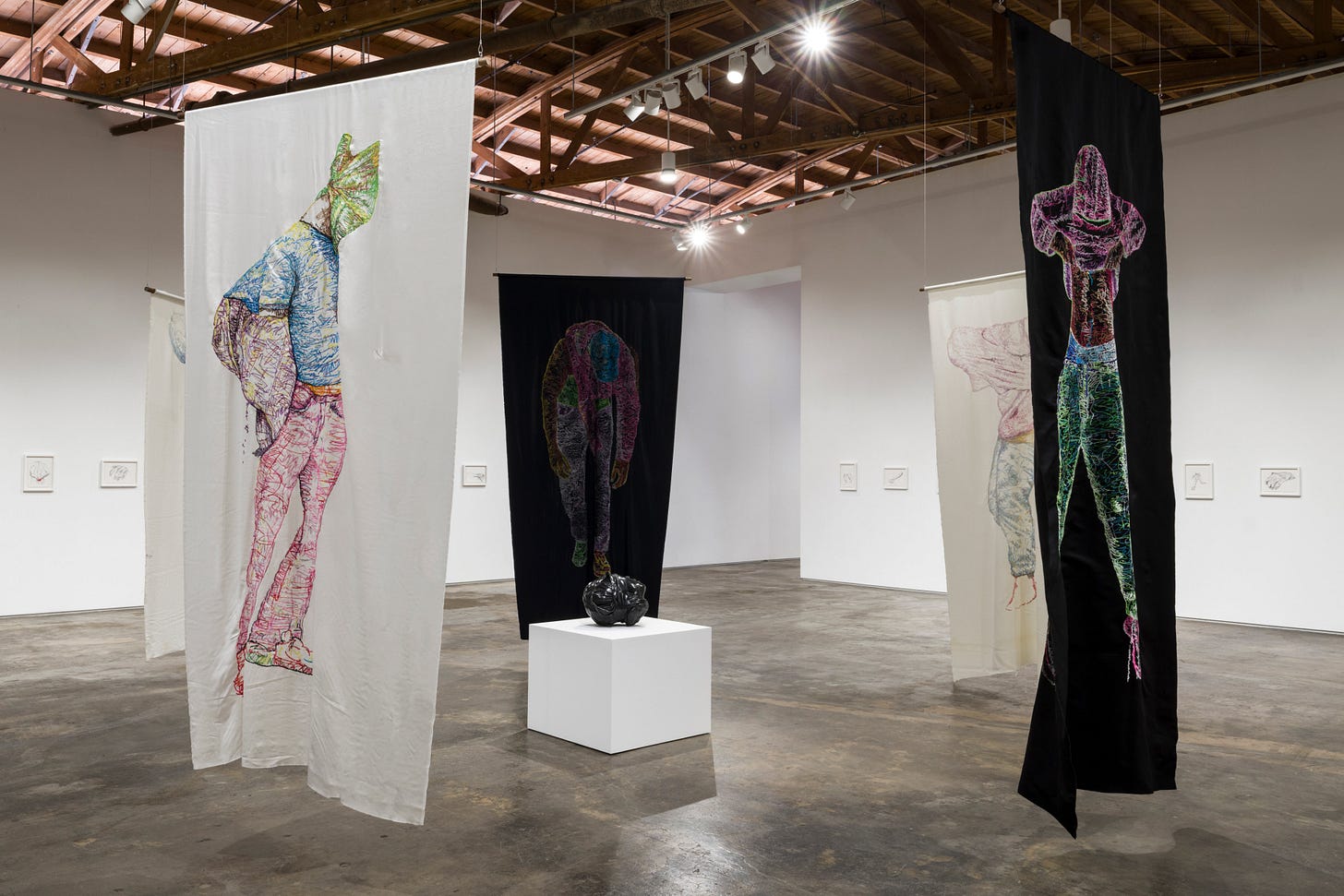Reza Aramesh at Night Gallery
Aramesh’s quiet, charged sculptures and textiles linger long after you leave the gallery. A review of his latest exhibition at Night Gallery in Los Angeles.
Reza Aramesh: Fragments of the Self
Night Gallery, Los Angeles
April 11 - June 28, 2025

You enter Reza Aramesh’s exhibition at Night Gallery through a sparsely laid out room consisting of three marble sculptures and three black-and-white photographs. The sculptures hinge somewhere between fetish and fragment, delicately rendered but disturbingly incomplete. Each one is a partial body, often just a torso or limb, carved in pristine white marble and on plinths that recall both classical museum displays and forensic evidence tables. These are not the heroic bodies of art history; rather, they are wounded, restrained, caught mid-surrender. Their postures evoke submission or trauma. Their fragments hint at the larger whole left behind.
Opposite them, the black-and-white photographs show marble busts toppled and shrouded, their faces obscured. Aramesh has long explored the visual language of violence as mediated through journalism and Western art history, and here the dialogue between image and object is sharply focused. The photographs are grainy, cold, and distant; the sculptures, by contrast, are sensuous, tactile, even intimate.

This contrast points to the central tension of the show: how aesthetic beauty can both reveal and obscure political violence. Aramesh doesn’t offer resolution; in fact, he stages the dilemma. His work asks us to consider what happens when suffering is stylized, when a news image becomes an art object, when the classical form is weaponized not to idealize, but to indict. You don’t need to look far to see this happening under our noses. Recall the widely circulated images of National Guard troops, deployed during the recent ICE raids in Los Angeles, lined up in front of Barbara Kruger’s Untitled (Questions) at MOCA Geffen—a towering mural rendered in stark red and white that asks: Who is beyond the law? Who speaks? Who is silent? Who salutes longest? Who prays loudest? The presence of uniformed armed men and women in front of a wall questioning power, complicity, and state violence rendered the artwork’s critique not only literal but almost self-consuming. It was a moment when the aesthetics of resistance met the optics of control, where visual dissent was absorbed into the very machinery it sought to question. Aramesh’s work doesn’t replicate these images, but he strips away at them until we’re left with just the space between representation and complicity.

Moving into the second room, the tone shifts. Less monumental, more intimate, but no less charged. A series of small graphite drawings line the walls, each depicting figures, but more so fragments, in various states of contortion, capture, or ritualized gesture. The linework is delicate, almost hesitant, as if the figures were being summoned rather than drawn. There’s a devotional quality to them, though these figures do not seem like saints; rather, they are subjects of surveillance and struggle. The compositions recall Renaissance studies and anatomical sketches, but without the clean detachment of scientific inquiry. These are bodies that feel known, lived-in, haunted.
Alongside the drawings hang Aramesh’s embroidered black or white silk panels where hooded figures from reportage are densely stitched in colors that quietly echo the Orientalist paintings invoked in their titles. At a distance, these works shimmer, almost ecclesiastical. Up close, the stitching tightens and loosens to play with light and shadow. The choice of embroidery, a medium traditionally coded as craft or domestic, becomes a quiet intervention to his works in the other room. Like the marble sculptures, these works live in tension: between care and brutality, ornament and wound, body and abstraction.

Taken together, the exhibition acts as a meditation on the aesthetics of power and how bodies are exposed and consumed. Through his processes, techniques, forms, and references, Aramesh seduces us and leaves us unsettled. Though his work draws from global archives of war, displacement, and resistance, it doesn’t immediately connote his own identity in any overt way. Aramesh is an Iranian artist based in London, yet his work does not necessarily register as “Iranian” in the way Western audiences often expect. There are no obvious cultural motifs, no visual signposts of nationality. And yet, the political charge is unmistakable. Like much Iranian art, his practice becomes political by default, subject to the persistent gaze that frames Iranian identity through conflict and geopolitics. Aramesh resists this flattening by turning away from national symbols and mythologies, focusing instead on the shared aesthetics of power and subjugation—images that cross borders, echoing through bodies rendered vulnerable by history, war, and state control. His work is not about identity as a label, but about the conditions that shape and threaten it.





